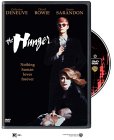| Reviews & Columns |
|
Reviews DVD TV on DVD Blu-ray 4K UHD International DVDs In Theaters Reviews by Studio Video Games Features Collector Series DVDs Easter Egg Database Interviews DVD Talk Radio Feature Articles Columns Anime Talk DVD Savant Horror DVDs The M.O.D. Squad Art House HD Talk Silent DVD
|
DVD Talk Forum |
|
|
| Resources |
|
DVD Price Search Customer Service #'s RCE Info Links |
|
Columns
|
|
|
Hunger, The
Warner Bros. // R // October 5, 2004
List Price: $19.97 [Buy now and save at Amazon]
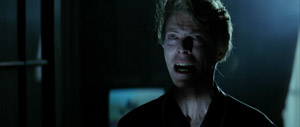 Tony Scott (Top Gun, Man on Fire) made his directorial debut with 1983's The Hunger, an unconventional vampire film starring David Bowie, Catherine Deneuve, and Susan Sarandon. Bowie and Deneuve star as John and Miriam Blaylock, a pair of immortals that have been wed for three hundred years. One day out of seven, they feed, leaving classical instrumentation behind in favor of Bauhaus' gothic-tinged rock, scouring the clubs of New York for their next meal. John's years suddenly start to catch up with him, and he turns to Sarah Roberts (Sarandon), a researcher investigating rapid aging that afflicts some young children. In the short while that John waits in vain for an appointment with a disinterested Sarah, he ages decades. Sarah realizes too late what's happening, and her repeated efforts to get in touch with him brings her closer to Miriam...far, far closer than she ever would have believed.
Tony Scott (Top Gun, Man on Fire) made his directorial debut with 1983's The Hunger, an unconventional vampire film starring David Bowie, Catherine Deneuve, and Susan Sarandon. Bowie and Deneuve star as John and Miriam Blaylock, a pair of immortals that have been wed for three hundred years. One day out of seven, they feed, leaving classical instrumentation behind in favor of Bauhaus' gothic-tinged rock, scouring the clubs of New York for their next meal. John's years suddenly start to catch up with him, and he turns to Sarah Roberts (Sarandon), a researcher investigating rapid aging that afflicts some young children. In the short while that John waits in vain for an appointment with a disinterested Sarah, he ages decades. Sarah realizes too late what's happening, and her repeated efforts to get in touch with him brings her closer to Miriam...far, far closer than she ever would have believed. The Hunger is an early example of a vampire movie that manages to go the entire length of the film without once uttering the word "vampire". That's an understandable decision, as The Hunger doesn't adhere to the established vampire mythos. Its creatures do feed on human blood as part of their everlasting life, but they don't fear stakes, sunlight, crucifixes, or garlic, at least not any more than the rest of us. They don't wile away their afternoons by sleeping in coffins. Rather than possessing razor-sharp fangs, these beings make their incisions with a small blade hidden inside a pendant in the shape of an Egyptian ankh. Not only are the creatures undeserving of the usual "vampire" label, but The Hunger itself can barely be characterized as a horror movie. The supernatural elements are fairly subdued, and this isn't a movie with an unambiguous set of heroes and villains. The real monsters aren't undead creatures of the night, but loneliness, old age, and death. Genre films typically place extensive emphasis on suspense, invariably having their hapless victims dart away from the killer, cowering in a dark, dank corner somewhere before their inevitable discovery moments later. The Hunger doesn't have a single scene like that. The kills are swift and brutal, and the vampires' victims barely have a moment's notice that their lives are quickly coming to an end.
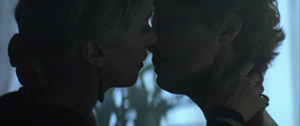 The Hunger is not a film that viewers searching for a coherent narrative should turn towards. The rapid aging, one of the central plot points of the movie, goes largely unexplained. There's a strange Egyptian flashback, the concept of which makes some amount of sense but still seems oddly out of place. The murder mystery aspect is only briefly touched upon and serves no real purpose. That's largely inconsequential -- The Hunger places its emphasis on mood and atmosphere rather than pushing forward some sort of formulaic plot. It benefits from the presence of three immeasurably charismatic leads, and Deneuve and Bowie effectively convey the quiet beauty, seductiveness, and isolation of these wealthy, elegant immortals. The Hunger is also a beautifully shot, very artful film. Its visual approach is probably more palatable now than it was two decades ago because of the wide adoption of that sort of style in the intervening years, particularly the rapid-fire cuts that open the film. And, of course, any review of The Hunger would be woefully incomplete without taking special note of the extended and near-legendary lesbian sequence between Sarah and Miriam. Vampire movies have always been tinged with some level of eroticism; the creatures have long been shown to hold their victims in a seductive thrall, and there are the obvious parallels with fangs penetrating the flesh and the flow of bodily fluids. The exchange of bodily fluids plays an even greater role in The Hunger, although the less said about that to the unfamiliar, the better.
The Hunger is not a film that viewers searching for a coherent narrative should turn towards. The rapid aging, one of the central plot points of the movie, goes largely unexplained. There's a strange Egyptian flashback, the concept of which makes some amount of sense but still seems oddly out of place. The murder mystery aspect is only briefly touched upon and serves no real purpose. That's largely inconsequential -- The Hunger places its emphasis on mood and atmosphere rather than pushing forward some sort of formulaic plot. It benefits from the presence of three immeasurably charismatic leads, and Deneuve and Bowie effectively convey the quiet beauty, seductiveness, and isolation of these wealthy, elegant immortals. The Hunger is also a beautifully shot, very artful film. Its visual approach is probably more palatable now than it was two decades ago because of the wide adoption of that sort of style in the intervening years, particularly the rapid-fire cuts that open the film. And, of course, any review of The Hunger would be woefully incomplete without taking special note of the extended and near-legendary lesbian sequence between Sarah and Miriam. Vampire movies have always been tinged with some level of eroticism; the creatures have long been shown to hold their victims in a seductive thrall, and there are the obvious parallels with fangs penetrating the flesh and the flow of bodily fluids. The exchange of bodily fluids plays an even greater role in The Hunger, although the less said about that to the unfamiliar, the better. Although The Hunger wasn't particularly well-received critically when it was originally released in 1983, it's certainly attracted a sizeable cult audience in the years since, and I feel it's aged well. This is not a film teeming with visceral thrills, pulse-pounding suspense, or whatever other similarly trite soundbites I could rattle off, and viewers should go in expecting a more deliberately paced movie than they may be accustomed to seeing. No one will mistake The Hunger for Blade II. The movie certainly has its share of flaws, particularly the scattershot plotting, but I enjoyed it and would certainly recommend The Hunger as a rental.
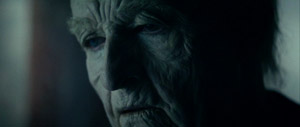 |
| "Forgive me." |
Audio: Considerably less remarkable is the Dolby Digital mono soundtrack, which sounds dated, thin, and insubstantial. It's disappointing to sit down with a DVD that looks so amazing but sounds this lackluster. A monaural French dub has also been provided, alongside closed captions and subtitles in English, French, and Spanish.
Supplements: The disc's audio commentary features director Tony Scott and star Susan Sarandon. As with the commentary on Warner's simultaneously-released Return of the Living Dead Part II, the participants were recorded separately and later pieced together. Sarandon's presence is almost negligible -- while she provides a few substantial comments, particularly her disappointment with the movie's epilogue, the sum total of everything she says adds up to just a few minutes. The majority of the track revolves around Scott, who notes his own 'hunger' at making his debut as a feature film director, making revisions to the source material as necessary to create something surreal and visually arresting. Various other topics include the difference between commercial directors and feature directors, noting about the popularity of his movies in gay circles, how he'd approach The Hunger if he were filming it today, and the restoration of the movie for this DVD. It's a very subdued track, and I think it likely would've been better suited to a shorter set of on-camera interviews than a feature length audio commentary.
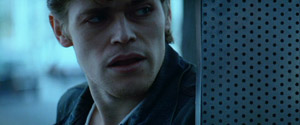 |
| Willem Dafoe in an early role that consisted of a single line of dialogue. |
Conclusion: The Hunger is a more thoughtful, art-house look at the vampire film. To some, that's a roundabout way of saying "boring", and to be sure, The Hunger won't appeal to all tastes. Speaking as someone who typically does lean towards faster moving, more traditional genre fare, The Hunger is a welcome change of pace, and I do recommend it. It's not the sort of movie I see myself watching incessantly, and because of that, I'd suggest The Hunger more as a rental than a purchase, but it is a film worth taking the time to see either way. Recommended.
|
| Popular Reviews |
| Sponsored Links |
|
|
| Sponsored Links |
|
|
| Release List | Reviews | Shop | Newsletter | Forum | DVD Giveaways | Blu-Ray | Advertise |
|
Copyright 2024 DVDTalk.com All Rights Reserved. Legal Info, Privacy Policy, Terms of Use,
Manage Preferences,
Your Privacy Choices | |||||||









